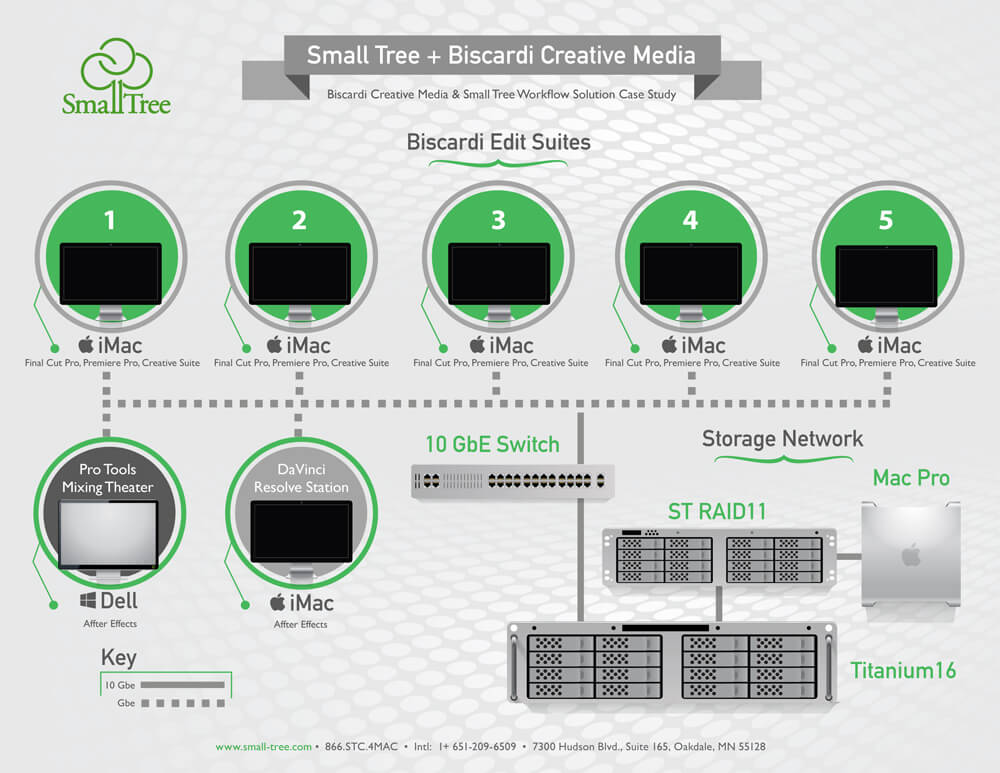Case Study: Biscardi Creative Media
Biscardi Creative Media
For many years, shared storage solutions seemed like they were out of reach for individual editors and small shops, but Small Tree Communications helped to change that. Biscardi Creative Media in Atlanta is a prime example of why storage networks aren’t a “heavy iron” investment any longer. Founded by Walter Biscardi, the company grew from its beginnings, working from Biscardi’s home, into a brand new, multi-suite facility a few years ago. During that journey Biscardi has been a Small Tree customer for the past seven years – expanding his investment from a single Small Tree unit years ago to now a 48TB ST RAIDII and the addition of a new Small Tree Titanium 32TB unit.
According to Biscardi, “I initially had three edit suites in the house and first wanted to tie two of them together. In the new facility, I’m operating five edit suites, plus a Pro Tools mixing theater and a DaVinci Resolve station – all of which are connected to a hybrid of our older and newer systems. The original Small Tree ST RAIDII uses an Apple Mac Pro as the media server, while the new Titanium 32TB RAID is an all-in-one unit, with an integrated server inside the chassis. Our edit systems include five Macs and one Dell PC and run a mixture of software, including Apple Final Cut Pro, Adobe Premiere Pro and Avid Symphony. Since we service outside producers, we have to be able to accommodate a number of different editing applications. In addition, we have a library database system and iMacs for our clients in all the suites. The bottom line is that we have a wide range of computers, operating systems and applications that are all able to access and work with media that lives on the Small Tree storage network.”
Biscardi’s storage is configured as volume-based media with the arrays divided into a total of six partitions. Workstations and client computers all connect using either 10GB or 1GB Ethernet ports via a 26-port 10GB Ethernet switch. Up to 24 computers are connected. The Thunderbolt-enabled iMacs connect to the switch using the Small Tree ThunderNet Ethernet-to-Thunderbolt adapter. As a facility that works on both outside shows for several networks and its own productions, the use of partitions makes it easy to keep ongoing work organized and accessible from any room. All media for a given production is stored within a folder structure on one of the partitions, so it is RAID-5 protected. Edit software project files are saved to the local machines, but then backed up to the Mac Pro media server for protection and for accessibility among the rooms.

When media comes in, it is ingested from videotape or file-based media (camera cards or hard drives) and placed into the appropriate folder. The librarian creates a top-level folder structure for that project according to a standard folder and subfolder organization method used at the shop. Videotape sources haven’t disappeared yet. With the introduction of Adobe Premiere Pro CC, Biscardi Creative has been able to move the videotape capture and output functions over to Premiere Pro from Final Cut Pro 7. Everything ends up in a single master folder for that job, which makes the archiving task easy. Currently Biscardi archives to raw hard drives, but is moving to LTO data tape. The entire set-up is less daunting than it sounds and Walter gives all the credit to Small Tree. “We have no staff IT department, so it’s great that this system has been very easy to set-up and administer. With Ethernet, you simply use the built-in network functions of the operating systems, without the need for any extra SAN management software. Adding a client producer onto the network, so they can review their footage, is literally as simple as plugging in a cable and setting up their network log-in. For our main systems, Small Tree has tuned each computer for the optimum playback performance and they can log in remotely to troubleshoot the system. Gig-E is fast enough for editing with several streams of ProRes media and 10Gig-E is handy now that we are dealing with uncompressed 2K files in some of our Resolve color correction sessions. As we grow, expanding the storage will be as simple as adding another Titanium storage chassis.”
Biscardi Creative Media has also worked with some of Small Tree’s smaller units, like the Titanium 5. They’ve used this for an on-site corporate editing project to connect the editor’s laptop and the client’s PC for a collaborative workflow. This is certainly an example for how shared storage is applicable to even the smallest installation, like a film editor working on location. Walter Biscardi views it this way, “The set-up is ‘stupid simple’. Small Tree has made it so easy that even clients can figure it out. As a facility owner, support is even more important. Storage solutions are at their best when you install them and forget them; but, when we have needed help, Small Tree has been there for us – even on weekends. The truth is that the system just works. I’ve been with them for seven years and I don’t see that changing. You just turn it on and

